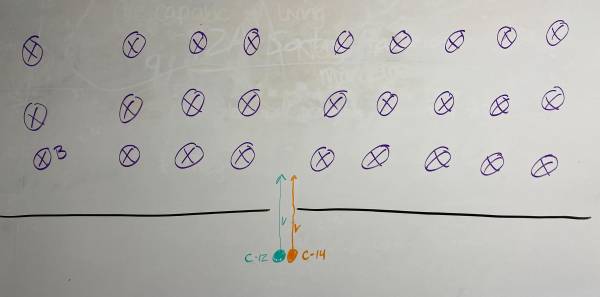Project: Sorting Hawkions
Since your team was so successful at creating the magnetic field detector, the Lakeviewians have now hired you to analyze other characteristics of the mystery particles. The particles appear to have a variety of masses, so you start by trying to sort the particles by mass for further analysis (using a mass spectrometer). Before building the spectrometer, your team is asked to develop a model of the spectrometer. The higher ups have specified that they would like to use a constant magnetic field of 2 T and to isolate the effects of the B-field within the magnetic housing box, but they are unsure what direction the magnetic field should be relative to the catching plate. Below is the beginning of a model that was developed by another team that mysteriously disappeared.
GlowScript 3.0 VPython ## Model parameters B = vec(0,0,0) ## Objects mag_housing = box(pos=vec(1,0,0), length=2, height=2, width=2, opacity=0.2) catchingplate = box(pos=vec(4,0,0), length=0.1, height=10, width=10, opacity=1) xaxis = cylinder(pos=vector(-3,0,0), axis=vector(6,0,0), radius = 0.05, color=color.white) yaxis = cylinder(pos=vector(0,-3,0), axis=vector(0,6,0), radius = 0.05, color=color.white) zaxis = cylinder(pos=vector(0,0,-3), axis=vector(0,0,6), radius = 0.05, color=color.white) ## Set up particles (DO NOT EDIT LIST) i = 0 N = 20 particleList = [] while i < N: particleList.append(sphere(pos=vec(-2-4*random(),0,0), radius = 0.1, m = 20*(random()+1), v = vec(2,0,0), q = 10, color=color.red)) i = i + 1 ## Calculation Loop t = 0 dt = 0.01 while t < 30: rate(300) for thisParticle in particleList: thisParticle.pos = thisParticle.pos + thisParticle.v*dt if thisParticle.pos.x > catchingplate.pos.x: thisParticle.v = vector(0,0,0) t = t + dt
Learning Goals
- Use the right hand rule to relate the charge's velocity and external magnetic field to the force on that charge.
- Use circular motion to relate the radius of the particle's trajectory to it's force
- Understand what an “if statement” does in the code
Conceptual questions:
- How is the right hand rule for magnetic field different from the right hand rule for magnetic force?
- Which of your particles are the heavier particles and which are the lighter ones? How do you know?
- What does an “if statement” in the code do?
- You calculated the force in the code, which has to be from something and on something. What is the force from and what is it on in the code?
- What would create a constant magnetic field?
- Why do you get circular motion for the particles?
- Do the particles speed up or slow down as they go through the magnetic field? Do the particles have an acceleration?
- How would you calculate the magnetic force on a charge? (Pick an magnetic field & charge velocity and do a sample calculation)
- Suppose you had two particles that were different isotopes of carbon. One particle is a Carbon-12 atom that is singly ionized, and the other particle is a Carbon-14 atom that has been singly ionized. If both particles are sent through a slot with a speed of 56.3 m/s into a 3 T magnetic field (shown below), where would they land?
